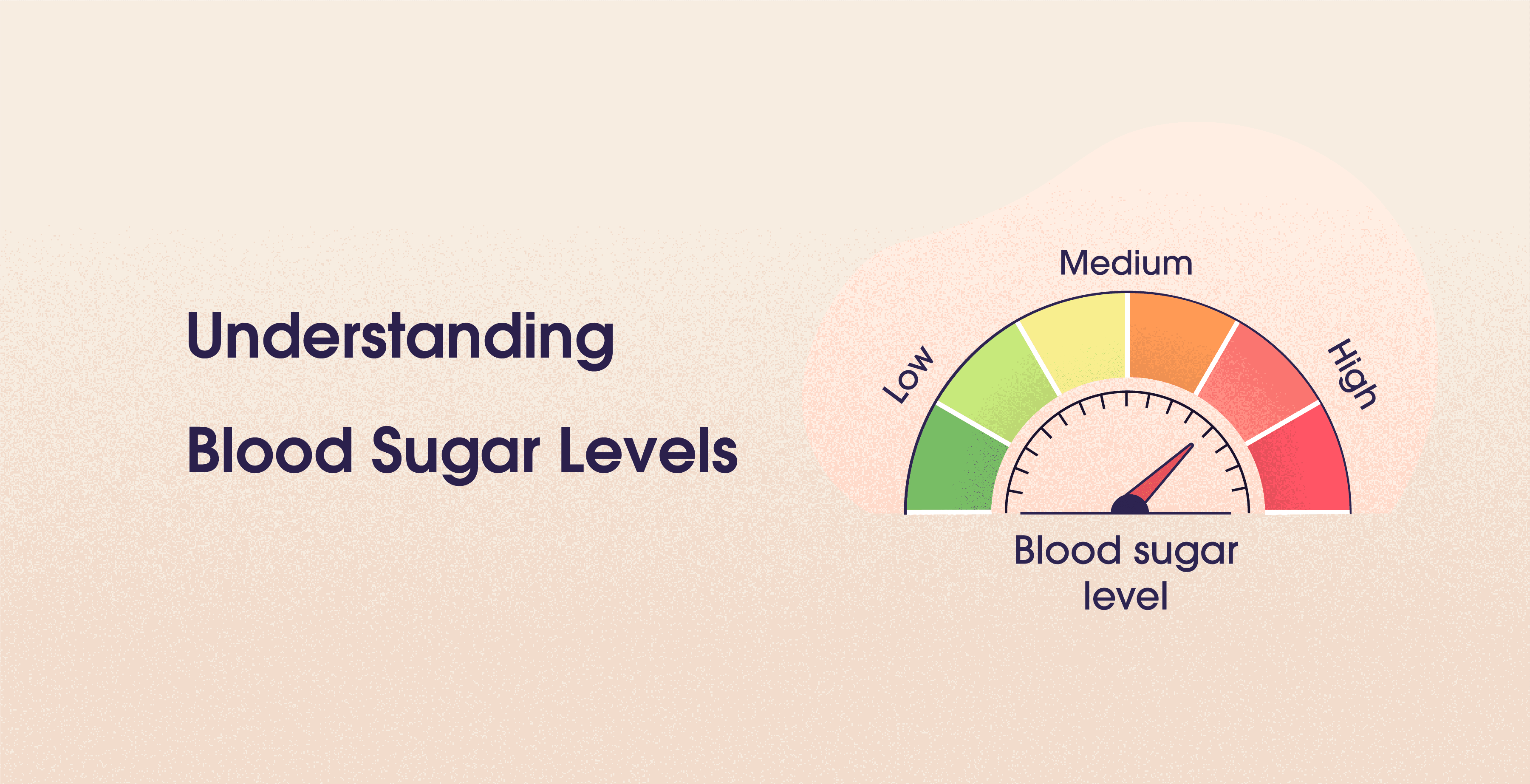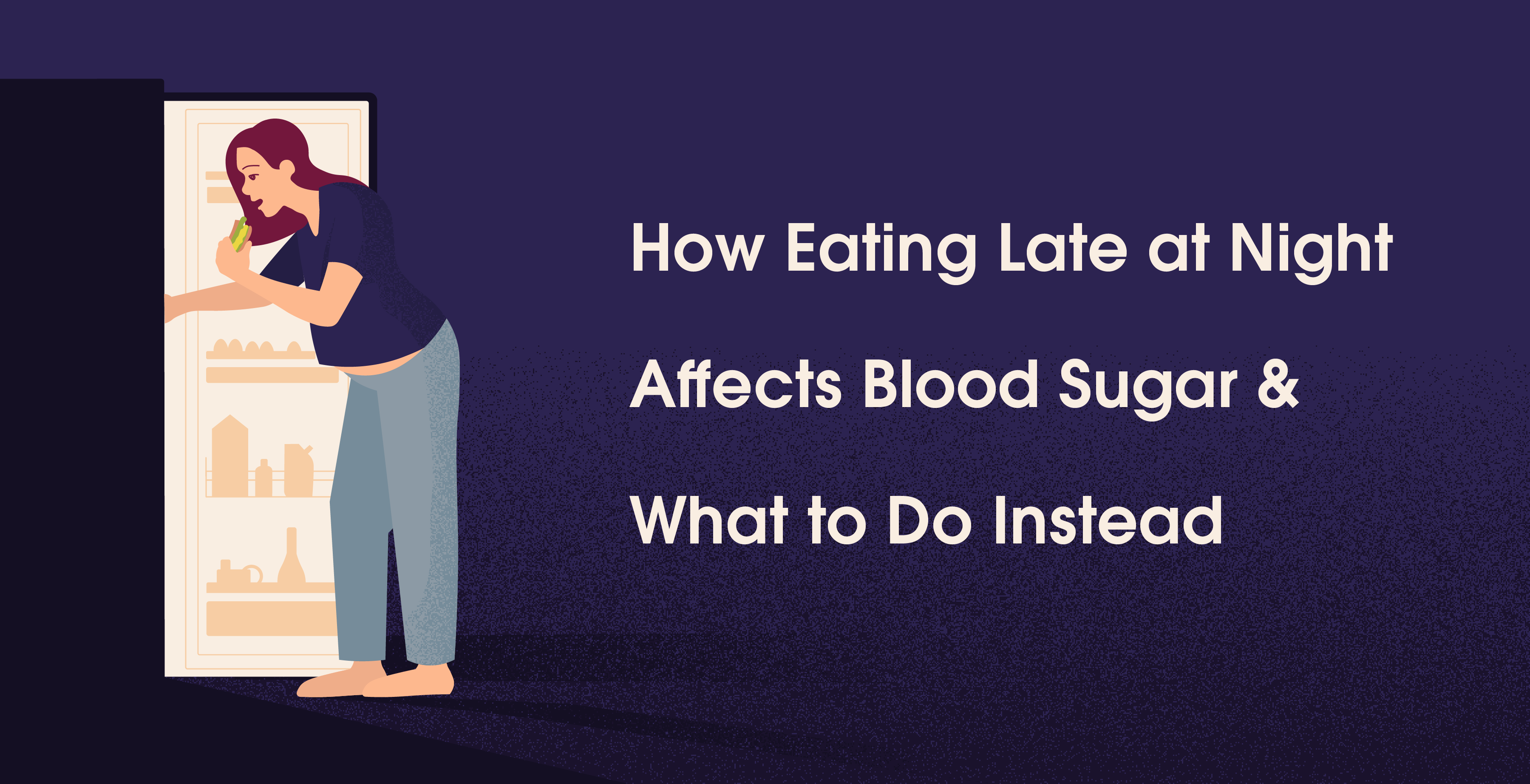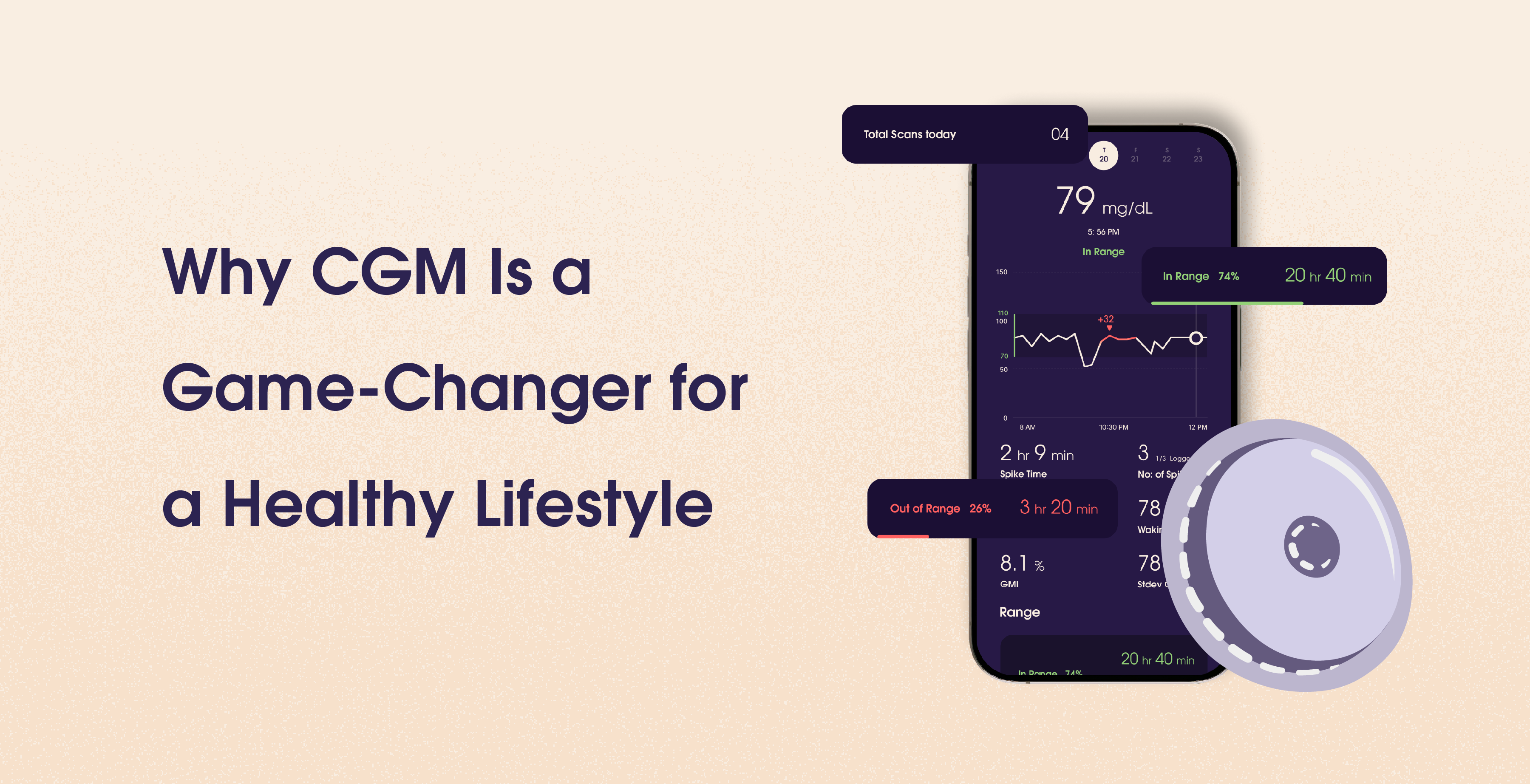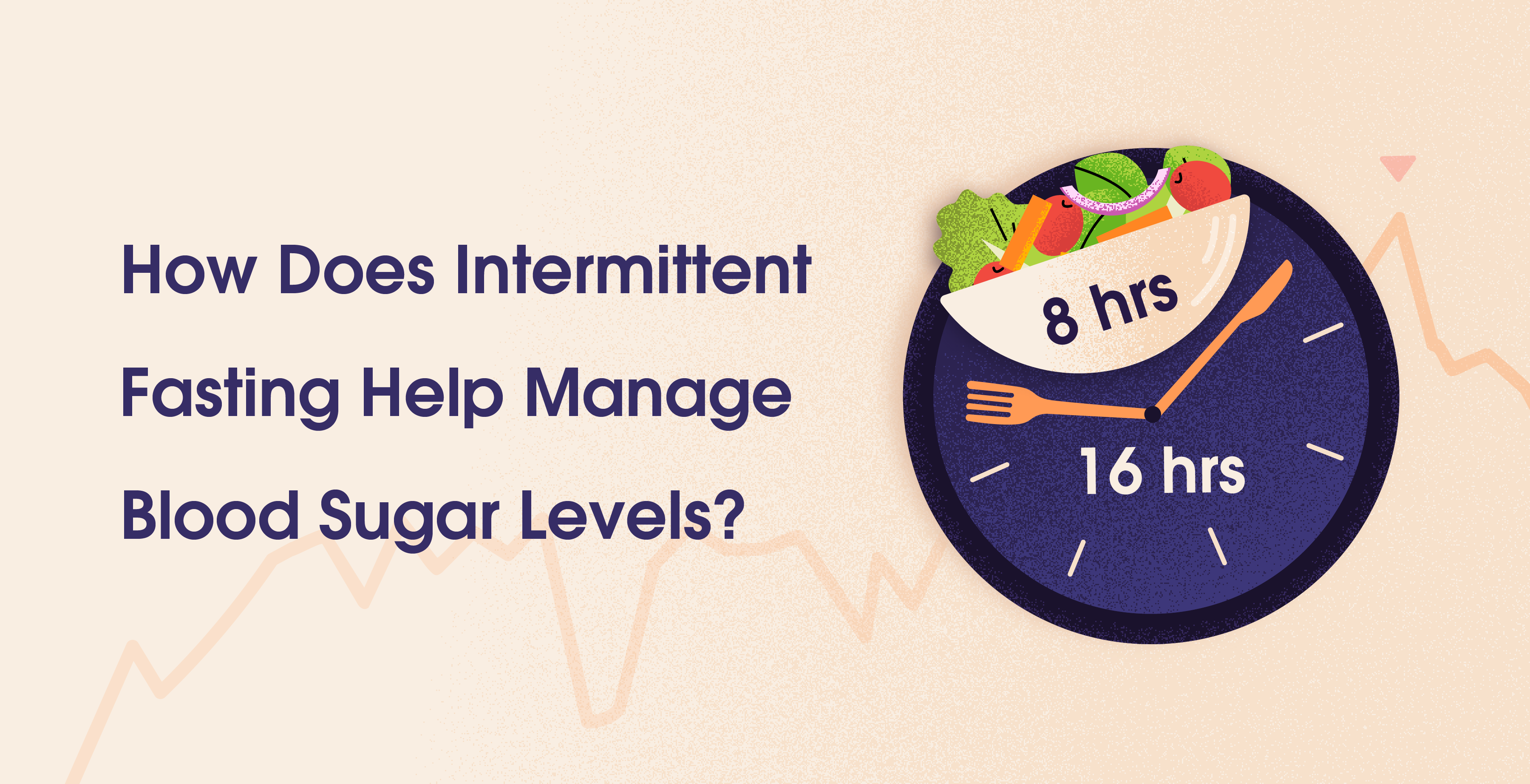Understanding Blood Sugar Levels
Sep 13, 2024
Sayfali Rawlani



Table Of Contents
Blood sugar, or blood glucose, is the amount of sugar (glucose) present in your blood at any given time. Glucose comes from the food we eat, especially carbohydrates like bread, rice, fruits, and sweets. When we eat, our body breaks down these carbohydrates into glucose, which is then released into the bloodstream. Blood sugar levels give us an indication of how much glucose is in the blood at a particular time, and also essential to maintain it. Understanding these levels plays a significant role in living a healthy lifestyle.
Highlights
Explanation of what blood sugar levels are and their importance in the body.
Importance of tracking blood sugar levels, especially for people with type 2 diabetes.
Guidelines for healthy blood sugar levels, including fasting and post-meal numbers.
Practical advice on diet, exercise, stress management, and hydration to control blood sugar.
Key symptoms of high (hyperglycemia) and low (hypoglycemia) blood sugar levels.
What Are Blood Sugar Levels?
Blood sugar level refers to the amount of blood present in your blood. Glucose is a type of sugar that makes up a majority of our body, our body gets glucose from the food we consume, especially from carbohydrates (carbs). It is a primary source of energy for the cells in our body. The level of blood sugar isn’t stable all the time, it changes according to your physical activity, and food consumption, and it’s even connected to our emotions.
Why Is It Important to Monitor Blood Sugar Levels?
Monitoring blood sugar levels is very crucial, especially for people who are pre-diabetics. Pre-diabetes is a condition where the body sugar level is actually above the normal limit but isn’t high enough to be at risk for type 2 diabetes. Once you start observing your blood sugar level you can easily manage it before it becomes too late. There are two types of conditions related to blood sugar levels in our body, let’s discuss them in depth:
High Blood Sugar (Hyperglycemia)
High blood sugar occurs when your blood has more glucose than required. When the excess glucose is not utilized by the body it can lead to high blood sugar levels leading to serious complications such as heart disease, type 2 diabetes, kidney damage, nerve damage, and vision problems over time.
Signs of Hyperglycemia:
Frequent urination
Increased thirst
Blurred vision
Fatigue
Headaches
Low Blood Sugar (Hypoglycemia)
Low blood sugar occurs when your body's sugar level is lower than normal levels. Low sugar levels can cause symptoms like shaking, sweating, feeling dizzy, and even fainting. If it is not treated, it can lead to more severe consequences including seizures, or loss of consciousness.
Symptoms
Shakiness
Sweating
Confusion
Irritability
Rapid heartbeat
What Are Normal Blood Sugar Levels?
Blood sugar levels are measured in milligrams of glucose per deciliter of blood (mg/dL). Here’s a general guide:
Fasting Blood Sugar (before eating): 70-99 mg/dL
Blood Sugar Two Hours After Eating: Less than 140 mg/dL
Random Blood Sugar (anytime): Less than 140 mg/dL
For someone with type 2 diabetes, these levels might differ slightly depending on the individual’s condition and the advice from their healthcare provider.
How to Maintain Healthy Blood Sugar Levels
Maintaining healthy blood sugar levels involves a combination of healthy eating, regular physical activity, and proper medication if needed. Here are some simple tips to keep your blood sugar in check:
Eat a Balanced Diet
Focus on adding a variety of flavors to your plate like fruits, vegetables, whole grains, and lean proteins. Avoid food that contains high amounts of sugar and processed carbohydrates, as they can spike your blood sugar level.
Be Physically Active
Regular exercise, such as walking, jogging, cycling, or swimming, helps your body use insulin more efficiently. Also, activities like weight lifting or body-weight exercises (e.g., push-ups and squats) can help build muscle, which in turn helps regulate blood sugar. Always aim to walk for 30 minutes minimum a day.
Our recommendation - We recommend you walk 30 minutes after every meal.
Monitor Your Blood Sugar Levels
If you have pre-diabetes or type 2 diabetes, you should always check your sugar level. You can also use a CGM to monitor your blood levels. This can help you understand how your body reacts to the food you are eating, exercising, and meditation.
Take Your Medication as Prescribed
If the doctor has prescribed you any medication or insulin to control your blood sugar level- follow them. We recommend you not to consume any medicine without doctors prescription.
Manage Stress
High stress levels can also be one of the causes of blood levels, and managing stress levels is key. Whenever you feel angry practicing deep breathing, meditation, and yoga are some of the best ways to control your stress, anxiety, and anger.
Stay Hydrated
Staying hydrated helps your kidneys flush out excess sugar through urine. Aim for 8-10 glasses of water per day, and avoid sugary drinks like soda and juice.
Conclusion
Understanding blood sugar levels is crucial to maintaining good health, especially for those with pre-diabetes and diabetes. When you know how your blood is reacting to the food you are eating, exercise, and other activities, you can easily maintain your body's sugar levels. CGM devices are always a good companion to have on your side to monitor your sugar levels.
Blood sugar, or blood glucose, is the amount of sugar (glucose) present in your blood at any given time. Glucose comes from the food we eat, especially carbohydrates like bread, rice, fruits, and sweets. When we eat, our body breaks down these carbohydrates into glucose, which is then released into the bloodstream. Blood sugar levels give us an indication of how much glucose is in the blood at a particular time, and also essential to maintain it. Understanding these levels plays a significant role in living a healthy lifestyle.
Highlights
Explanation of what blood sugar levels are and their importance in the body.
Importance of tracking blood sugar levels, especially for people with type 2 diabetes.
Guidelines for healthy blood sugar levels, including fasting and post-meal numbers.
Practical advice on diet, exercise, stress management, and hydration to control blood sugar.
Key symptoms of high (hyperglycemia) and low (hypoglycemia) blood sugar levels.
What Are Blood Sugar Levels?
Blood sugar level refers to the amount of blood present in your blood. Glucose is a type of sugar that makes up a majority of our body, our body gets glucose from the food we consume, especially from carbohydrates (carbs). It is a primary source of energy for the cells in our body. The level of blood sugar isn’t stable all the time, it changes according to your physical activity, and food consumption, and it’s even connected to our emotions.
Why Is It Important to Monitor Blood Sugar Levels?
Monitoring blood sugar levels is very crucial, especially for people who are pre-diabetics. Pre-diabetes is a condition where the body sugar level is actually above the normal limit but isn’t high enough to be at risk for type 2 diabetes. Once you start observing your blood sugar level you can easily manage it before it becomes too late. There are two types of conditions related to blood sugar levels in our body, let’s discuss them in depth:
High Blood Sugar (Hyperglycemia)
High blood sugar occurs when your blood has more glucose than required. When the excess glucose is not utilized by the body it can lead to high blood sugar levels leading to serious complications such as heart disease, type 2 diabetes, kidney damage, nerve damage, and vision problems over time.
Signs of Hyperglycemia:
Frequent urination
Increased thirst
Blurred vision
Fatigue
Headaches
Low Blood Sugar (Hypoglycemia)
Low blood sugar occurs when your body's sugar level is lower than normal levels. Low sugar levels can cause symptoms like shaking, sweating, feeling dizzy, and even fainting. If it is not treated, it can lead to more severe consequences including seizures, or loss of consciousness.
Symptoms
Shakiness
Sweating
Confusion
Irritability
Rapid heartbeat
What Are Normal Blood Sugar Levels?
Blood sugar levels are measured in milligrams of glucose per deciliter of blood (mg/dL). Here’s a general guide:
Fasting Blood Sugar (before eating): 70-99 mg/dL
Blood Sugar Two Hours After Eating: Less than 140 mg/dL
Random Blood Sugar (anytime): Less than 140 mg/dL
For someone with type 2 diabetes, these levels might differ slightly depending on the individual’s condition and the advice from their healthcare provider.
How to Maintain Healthy Blood Sugar Levels
Maintaining healthy blood sugar levels involves a combination of healthy eating, regular physical activity, and proper medication if needed. Here are some simple tips to keep your blood sugar in check:
Eat a Balanced Diet
Focus on adding a variety of flavors to your plate like fruits, vegetables, whole grains, and lean proteins. Avoid food that contains high amounts of sugar and processed carbohydrates, as they can spike your blood sugar level.
Be Physically Active
Regular exercise, such as walking, jogging, cycling, or swimming, helps your body use insulin more efficiently. Also, activities like weight lifting or body-weight exercises (e.g., push-ups and squats) can help build muscle, which in turn helps regulate blood sugar. Always aim to walk for 30 minutes minimum a day.
Our recommendation - We recommend you walk 30 minutes after every meal.
Monitor Your Blood Sugar Levels
If you have pre-diabetes or type 2 diabetes, you should always check your sugar level. You can also use a CGM to monitor your blood levels. This can help you understand how your body reacts to the food you are eating, exercising, and meditation.
Take Your Medication as Prescribed
If the doctor has prescribed you any medication or insulin to control your blood sugar level- follow them. We recommend you not to consume any medicine without doctors prescription.
Manage Stress
High stress levels can also be one of the causes of blood levels, and managing stress levels is key. Whenever you feel angry practicing deep breathing, meditation, and yoga are some of the best ways to control your stress, anxiety, and anger.
Stay Hydrated
Staying hydrated helps your kidneys flush out excess sugar through urine. Aim for 8-10 glasses of water per day, and avoid sugary drinks like soda and juice.
Conclusion
Understanding blood sugar levels is crucial to maintaining good health, especially for those with pre-diabetes and diabetes. When you know how your blood is reacting to the food you are eating, exercise, and other activities, you can easily maintain your body's sugar levels. CGM devices are always a good companion to have on your side to monitor your sugar levels.
Table Of Contents
Table Of Contents
Table Of Contents
Read More


Mar 25, 2025
Sayfali Rawlani


Mar 20, 2025
Sayfali Rawlani


Mar 6, 2025
Sayfali Rawlani



Company
Copyright © 2025 trst health. All right reserved.

